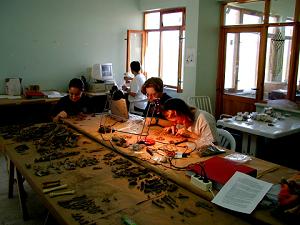Animal Bone Studies
Louise Martin and Nerissa RussellDuring 2000, work in the faunal laboratory focused on completing the East Mound units selected for integrated analysis for the forthcoming project publications. Recording of Building 1 material was completed, as was a selection from Building 5, Space 181, Kopal, and other areas which had been chosen to provide representative samples of spatial and temporal variability. |
 Figure 23: Work in the bone lab |
The list of animal species identified remains the same as from previous seasons work, and general trends in the relative importance of the various animals are also confirmed. Sheep, and to a lesser extent goats, continue to be most common in nearly all areas of the site, suggesting that the herding of these animals was an important source of meat. The combined evidence of high proportions of sheep/goats, small animal size, and penning deposits strongly suggest that sheep (at least) were domestic from the earliest occupation. We are still uncertain of the domestic/wild status of the cattle at Çatalhöyük, but regardless, the increasing evidence for cattle feasting shows the important place that these animals held in the social and symbolic lives of the inhabitants. Wild boar and deer appear to decrease in number throughout the occupation. Both animals are represented by all body parts in the earlier deposits, but later, deer especially are present mainly as cranial remains. Either they are processed in a way that leaves the meaty parts of the body off-site, or they are no longer hunted nearby, but only selected parts, such as antlers, are brought in for their symbolic and technological value. We continue to identify three types of wild horses and asses, including Equus caballus (wild horse) throughout the sites sequence, which is an interesting addition to knowledge of this animals distribution.
This season, we also exported samples of bird bone, eggshell, fish bone and microfauna for identification by various specialists. These samples will be re-imported to the site once analysis is complete. A major period of faunal analysis now begins which will include detailed identification and quantification, analysis of size and shape, cull pattern and body part analyses, consideration of the way human and natural factors alter bone and bone modification.